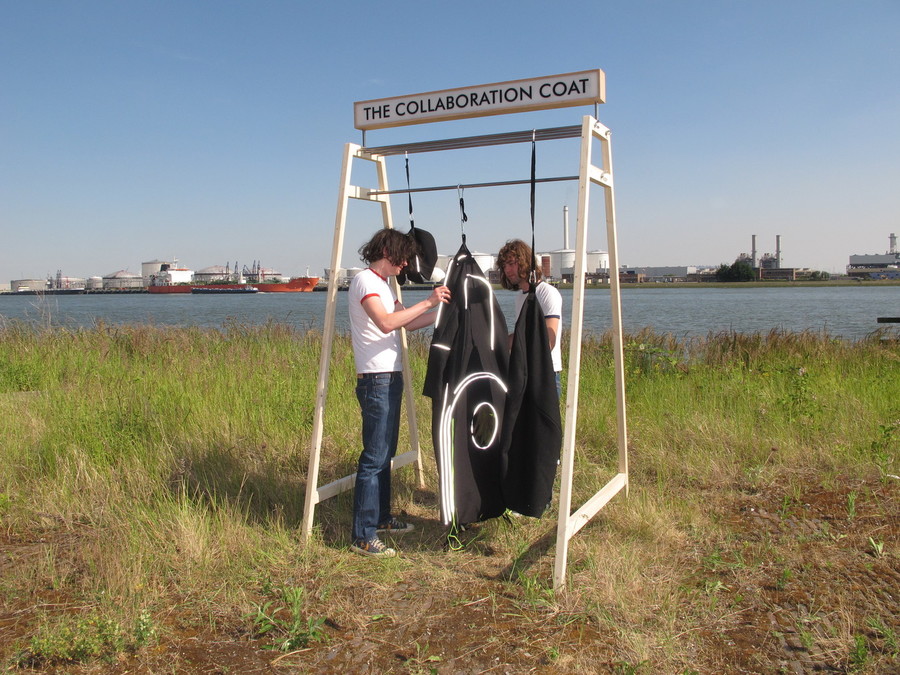Difference between revisions of "The Collaboration Coat"
| Line 32: | Line 32: | ||
By the same token, users experience a fundamental critique on the fast-fashion-industry, not by being offered a 'ready-to-wear' option, but by being committed to fashion-as-social-practice. | By the same token, users experience a fundamental critique on the fast-fashion-industry, not by being offered a 'ready-to-wear' option, but by being committed to fashion-as-social-practice. | ||
| − | + | ||
| − | <gallery> | + | <gallery mode="slideshow"> |
2 TCC Charlotte Jansen.jpg | 2 TCC Charlotte Jansen.jpg | ||
5 TCC Charlotte Jansen.JPG | 5 TCC Charlotte Jansen.JPG | ||
Revision as of 10:27, 12 October 2017
When I started studying fashion at WdKA, six years ago, it took some time to settle in a practice-oriented curriculum, since what I had expected on entering was to graduate one day with a collection of eight outfits presented in a ‘classic’ fashion show. But because times had changed, WdKA had changed too. So I changed as well, and over these past six years I started to critically question the fashion system we still are familiar with today.
Focusing on Social Practice WdKA offered me a great opportunity to immerse myself in reflecting on why we use fashion to exhibit our social status and whether we really have a say in this particular context.So what are those consequences?
I came to realize that fashion is exemplary for lots of industries that lure us into a incessantly buying. Buying has become an addiction in which we are conditioned to sustain a system that influences not only ourselves but people all over the world. Can we still make a difference between conditioning and critique? Do we still have a choice? If so, we first and foremost need to become fully aware of the consequences of our consumerist lifestyle.
Most people will know that fashion has a huge impact not only on the environment but also on crucial socio-economic factors in cheap-labour production countries. Nevertheless, we keep on shopping like never before. What most people will not know is the great impact of fast fashion on our own daily lives. We are conditioned by fashion advertising, news-feeds, and social media; all of which shape our ideas about how we should present ourselves in order show our 'real selves’, but more importantly, in doing so, they simultaneously reset our ideas about ‘others’. Our social interaction is therefore based on biased presumptions about appearances in/as clothing.
Social design shows us through recognition, cross connection,
and collaboration how to make a difference.
So when I started my research for my graduation project I knew I had to reach out to fast fashion consumers in order to offer them a critical perspective on the social interactions they are implementing in their being dedicated followers of fashion. I realized the way to do this was by using their language – i.e the register of fashion. I therefore mobilized fashion so as to criticize its system.
I called my project The Collaboration Coat.
The Collaboration Coat unravels outer-identity and encourages social interaction that goes beyond fast-fashion logistics. It is based on inner-identity. It is a garment that is tailored to a sustainable social interaction that is suppressed by the fast-fashion system. So instead of creating an artificial desire to consume, my installation meets with real emotional and practical needs by asking for patience, trust, helpfulness, appreciation and collaboration.
How does it work?
My coat only reveals its potential when people work together. So you need to collaborate in order to make it work. The Collaboration Coat exists out of a huge clothing rack, in which pieces of garment hang on belts, as if it were marionettes. What they symbolize is the immense power of the fast-fashion-industry. These pieces can be unfolded, zipped together or turned inside out, while each activity asks for patience, trust, helpfulness, appreciation or collaboration.
So this is not about tastes or trends. This is about retracing everyday social interactions we are dearly missing because of the fast-fashion industry.
By the same token, users experience a fundamental critique on the fast-fashion-industry, not by being offered a 'ready-to-wear' option, but by being committed to fashion-as-social-practice.
Links
CONTRIBUTE
Feel free to contribute to Beyond Social.











